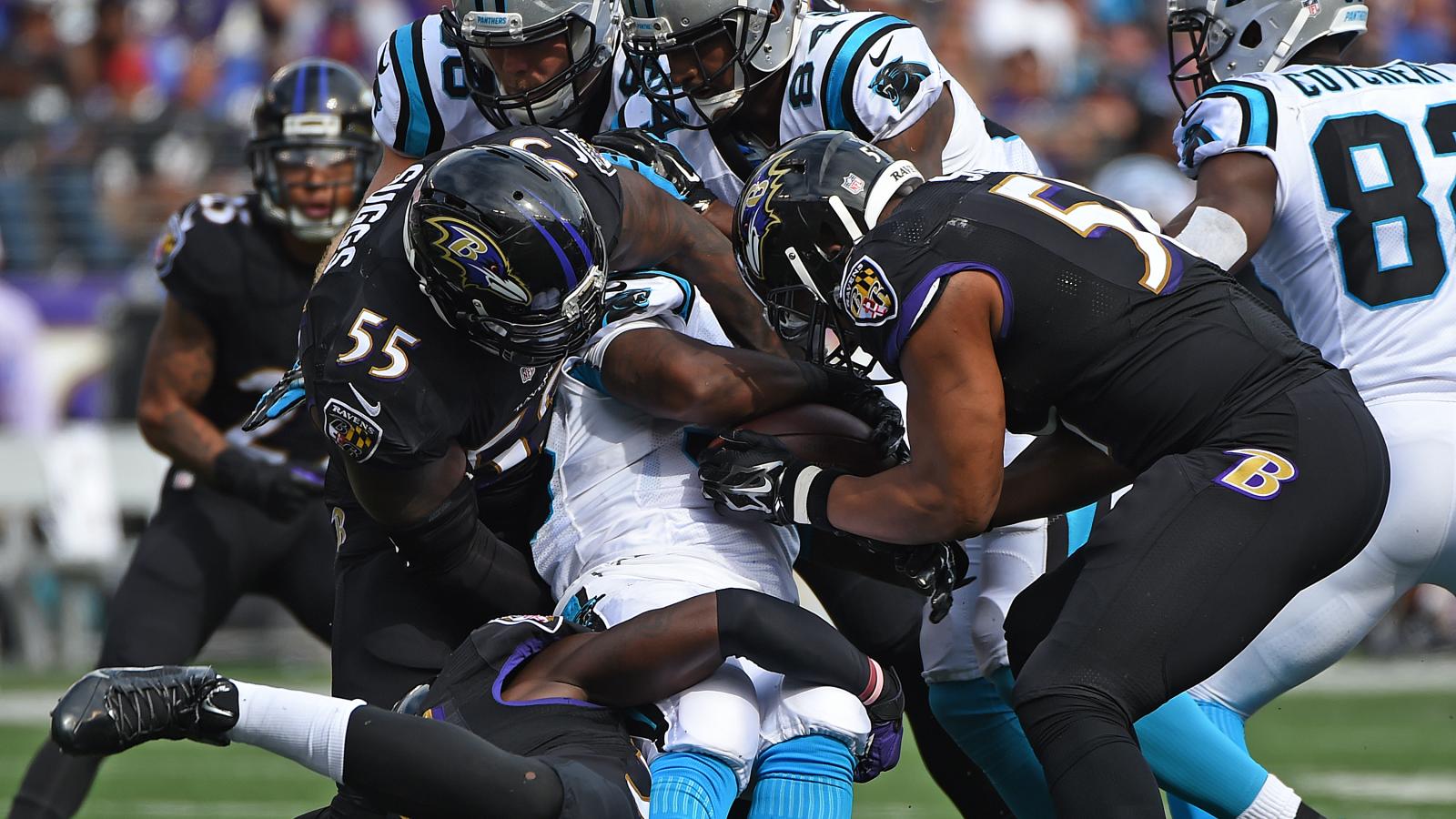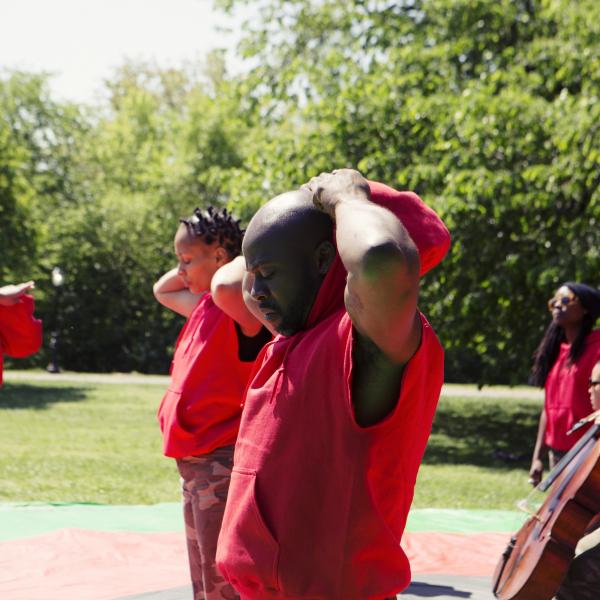Leading at Halftime

People talk about the "art" of football, but they aren’t referring to art literally—rather they are talking about the skill and technique required to play the sport well. But there is an art to football, perhaps unnoticed consciously by the majority of the audience on any given Sunday (or Monday night…or Thursday night). This can be as simple as the design of the team logo or the uniforms—the colors, the shapes, the patterns. Or it could be something much larger, as large as the design of the stadium itself in which the game is played. To take a look at where art is around us during a football game, we turned to the NFL team the Baltimore Ravens—possibly the only major sports team named after a literary work.
The team’s name came from the poem “The Raven” by Edgar Allan Poe. Poe died in Baltimore (most miserably if truth be told), where he was buried, so his connection to the city was well-established. It wasn’t the team’s owner who chose the name, however—it was the people of Baltimore. “The first promise we made was that we’d bring this [naming of the team] back to the fans in some way,” said David Modell, then-assistant to the Ravens’ president. This involved focus groups to narrow down the possibilities, and then a poll through the Baltimore Sun newspaper, in which the name Ravens was overwhelmingly the choice by four to one. The site of the Ravens’ playing field, M&T Bank Stadium, was built a short distance from Westminster Hall and Burying Ground where Poe is buried (his headstone decorated with an engraved raven).

|
The current stadium, built in 1998, is located at the site previously occupied by the William Knabe piano factory; today, a stone mosaic of piano keys is displayed at the stadium in its honor. Although the practical aspects of designing a stadium took precedence (moving large groups of people safely), the design firm also wanted to include aesthetic elements that related to the team and the community. Since the stadium was located right in the city (as opposed to many stadiums that live in the suburbs), Baltimore’s architecture served as a basis for some of the design.
“[We were] pulling from the city, the character, the history of the old industrial buildings, the brick warehouses, and things like that,” said Ben Stindt, the design architect on the project, which was managed by the firm Populous (formerly HOK). “Back in the day when a lot of those industrial buildings were built, the brick was a handmade modular type of architectural unit of masonry…. That brick has a special feeling that said, ‘Hey, this is Baltimore.’ This is downtown, this is the character of all the shops and bars and restaurants and street life that you go to.” Stindt went around the city and noted all the different architecture, the historic buildings, and the brick details, and then tried to mimic that in the stadium design elements. “The actual bricks we used were iron-flashed brick—to make them look antique. Maybe a lot of people don't [notice], but when you walk around that stadium, you have a sense of the context, that beauty that's such an historic part of Baltimore.” The design also helped the stadium fit right in with the surrounding architecture, making it seem like the stadium had always been a part of the city.
It was not just buildings that they relied on—Stindt also looked at the steel bridges around the city, and mimicked the arches and truss work in the upper decks of the stadium. There were some playful artistic additions as well. For example, outlined between the hash marks near the statue of Johnny Unitas near one of the stadium entrances, unnoticed perhaps by those walking over it, is a classic passing play diagrammed in the X’s and O’s of football parlance. Also, in tribute to the new team, the outline of the Ravens logo was embedded in some of the brick detail work.

|
When the stadium was completed, the football team’s marching band (only one of two NFL marching bands in the league) changed its name from the Baltimore Colts Marching Band to the Marching Ravens. In case you had any misconceptions about the power of music, the band continued functioning as the Baltimore Colts Marching Band even after the Colts football team left town in the middle of the night in 1984. For 12 years, it played at Baltimore functions and at the request of several NFL teams during their games, until Baltimore acquired a new NFL team. In fact, the band played at the Maryland State House during a crucial vote for the building of the stadium and was the reason for the success of the vote, according to then-Governor William Donald Schaefer.
The band is not made up of full-time professional musicians, but instead of people who love both music and football, 150 members strong, and topping 200 when counting staff and equipment crew. According to Dan Fake, the musical director, most of the people who join the band have six to eight years of musical experience, usually through high school, college, or a military band, and almost all have full-time jobs (Fake is a high school music teacher).
For the Marching Ravens, game days start in the morning outside the stadium, marching through the tailgate parties in the parking lot and down RavensWalk. Once in the stadium, they do a pregame concert for the fans as they are getting to their seats, rousing them for the game with the “Raven's Fight Song” or the White Stripes’ “Seven Nation Army,” which has become a fan favorite. The band then performs a halftime show, usually a series of songs grouped thematically, with a new theme for each home game. As a marching band, the musicians go through drills as they play, creating an intricate choreography that blends the musicians’ need for keeping time with innovative and aesthetically pleasing designs for the crowd. Both before and after halftime, the band sits in the stands and plays during timeouts and big plays. After the game, they march back through the parking lot.

|
For such an intricate program, you would expect a goodly amount of rehearsal—but the Marching Ravens meet just once a week, for three hours every Wednesday night. “We are known as the 'Miracle Band,'” said John Ziemann, president of the Marching Ravens and a member of the band for more than 50 years. "We've been called that around major colleges, because most bands get seven days a week, three or four or five hours a day. We only get three hours from 7-10 p.m. on a Wednesday night. That's it." And yet the Marching Ravens are considered a premier marching band, having played in national events such as the Macy's Thanksgiving Day Parade as well as local Baltimore events such as the July 4th parade.
One of the most important aspects of the marching band to Fake is that the fans are "getting music in a non-concert setting." Playing music that the audience knows but in a different context helps bring them into the music. "Sometimes it gets a little hard for us as the teachers, or even as the performers," said Fake, "to find the beauty in some of the songs when they've been taken from guitars and put into a marching band. But when you come across it, and you start to have a bit of personality that goes along with the music, it can be a pretty spectacular thing."
A bit of personality would be a good descriptor for the Ravens' cheerleading crew as well. "I feel like the band and cheerleaders and the mascot all bring energy into the stadium," said Tina Galdieri, director and coach of the Baltimore Ravens Cheerleaders. "I think we have a dual role: A big part is entertainment, doing really good dances and having good performances, and things like that. And to keep [the crowd] interactive and interested and rooting for the team."

|
But it also involves a great deal of creativity and work. A whole choreography routine requires anywhere from 12 to 15 hours of practice and the same strenuous workout and risk of injuries as professional dancers face. In addition, the Ravens Cheerleaders have a stunt team made up of male and female members that performs gymnastic feats—tumbling, leaping, throwing women into the air like fireworks. All of this takes not only hard work, but an artistic sense to create the routines. "I absolutely do think that what we do is art," said Galdieri, "partly because of the choreography and our performance level and how we look at dance as art."
People coming to a football game aren’t looking for art though. They’re looking for a tough, often brutal, complex sports contest. And yet it is there anyway, surrounding the crowd whether they recognize it or not, because even in the most unlikely places there is an element of creativity that blooms and makes itself known.







